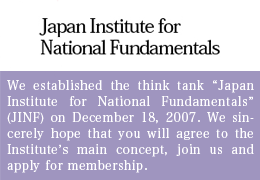JAPAN AND US MUST COLLABORATE TO SURPASS CHINA IN WORLD FINANCE AND ECONOMY
Xi Jinping’s ambition to realize his “Chinese dream” distinctly colored the recent summit of the Asia-Pacific Economic Cooperation Conference (APEC) in Beijing.
Xi’s behavior on November 10 during a photo session with Prime Minister Shinzo Abe preceding the Japan-China summit was unworthy of a world leader, bordering on rudeness. He neither responded to Abe’s greetings nor smiled during the brief time in which the two leaders stood before the cameras, acting as though time hung heavy on his hands. Did this willful posture on the part of Xi reflect his emotional rejection of Japan, which will not follow a world order China is eager to lead, or was his arrogance possibly traceable to his innate sense of China, the “Middle Kingdom,” as indeed being at the center of the world?
At the summit, China had an eye on the early establishment of the Free Trade Area of the Asia Pacific (FTAAP), expecting the summit to spell out 2025 as the starting year of a new free trade area in the region. Although APEC this time did not specify the timing, as the US and Japan are first committed to prioritizing establishment of the TPP (Trans-Pacific Partnership), China’s assertion laid bare its strong will to set up a new international financial and economic mechanism spearheaded by China.
Obvious from China’s eagerness to design such a mechanism is an initiative taken by the Communist Party to expand China’s influence even at the risk of neglecting rational economics. The Asian Infrastructure Investment Bank (AIIB) is one such project.
AIIB was inaugurated on October 24 with 21 nations participating. It headquartered in Beijing and headed by a Chinese president. It seeks to eventually increase its capital to US$100 billion, which will be shared by member nations in proportion to their GDP. No doubt, China will play the leading part.
Through this new financing structure, China plans to utilize part of the US$4 trillion it has in its foreign currency reserves to provide funds to Asian nations desiring to improve infrastructure. Asian nations are believed to require an estimated total of US$8.2 billion for infrastructural investments in the decade ending in 2020—clearly too large a sum for existing financial institutions, such as the Asia Development Bank, to provide.
But it is difficult to conceive that AIIB will actually be able to help improve the economic conditions of these Asian nations. Instead, it is feared that it will create seriously negative economic and political effects across Asia.
Accumulation of Endless Bad Debts Throughout the World
China has to date extended economic assistance solely with the objective of benefitting its own national interests. As was seen in its aid to the Sudanese government infamous for the 2003 genocide in Darfur that claimed 400,000 lives, China completely ignores the domestic circumstances of aid recipients. By purchasing natural resources it covets, including oil, while providing aid, Beijing has to date supported dictators who thought nothing of massacring their own people.
Extension of AIIB loans is expected to be done in the same format—that of paying no attention to the local political situations, human rights violations, or environmental destruction. Because economic rationality will not be the basis for granting loans, there is no denying the danger of AIIB accumulating a mountain of bad debts around the world.
On October 24, Finance Minister Taro Aso rightly wondered if AIIB is “capable at all of screening borrowers.” Devoid of the slightest intention of properly governing its financial institutions, China should be viewed as intent on expanding its spheres of influence, fully applying its financial power.
No financial system can perform its functions well when political considerations take precedence over economic rationality, and the problems faced by the very Chinese economy which is bound to sustain AIIB are indeed serious. Comments Ryoji Musha, who heads Musha Research in Tokyo:
“China’s foreign currency reserves stood at US$2.85 trillion at the end of 2010 and US$3.18 trillion at the end of 2011. They continued to increase to US$3.31trillion in 2012, US$3.28 trillion in 2013, and topped out at US$3.89 trillion at the end of September this year. The source of China’s capital power has been its huge foreign currency reserves, which are among the world’s biggest. Now, however, we can safely say increases in China’s foreign currency reserves are a thing of the past.”
Not only can we expect that China’s foreign currency reserves will begin to decrease, we will also see the qualitative nature of those loans to deteriorate. Explains Musha:
China’s foreign currency reserves have in the past resulted from its trade surplus. Now, however, a significant portion of foreign currency comes from a variety of other sources. This would include loans obtained through subsidiaries of Chinese companies overseas, capital raised from stock listings such as the September listing on the New York Stock Exchange of Chinese Internet giant Alibaba Group Holding Ltd., and foreign currency obtained through syndicate loans. However, the various conditions that have brought China huge trade surpluses in the past have started to deteriorate. For instance:
●Personnel costs in China, especially in coastal areas such as Guangzhou and Shanghai, are among the highest in Asia today. Investments once directed at China to obtain cheap labor are now clearly beginning to shift elsewhere in Asia;
●Direct investments in China have declined drastically. Japanese investments in China this year have dropped by 43% from last year. European and US investments in China have dwindled by around 20% across the board; and,
●Portfolio investments in China, including investment securities and real estate investments, are beginning to show undeniable signs of decrease.
China’s foreign currency reserves grew dramatically in 2013 despite the absence of prospects of an increase in trade surpluses, direct investments in China, or securities investment. The reason: as mentioned earlier, Chinese corporations managed to raise capital overseas. In other words, there was a sudden inflow of huge amounts of loans from abroad. As a result, China currently has US$4 trillion in foreign currency reserves. The abundance in China of foreign currency, much of which was obtained through less than ideal means, actually indicates the fragility of China’s financial and economic health. I suspect that this is acutely understood most by none other than the Chinese themselves.
The Hangover after the Party
In view of the fact that there exist in China the so-called “luo guan” elite bureaucrats (who have moved their families and wealth overseas, ready to desert China at any time) as well as high-net-worth individuals who have remitted more than US$10 billion to foreign banks, it is clear that money will from now on fundamentally flow out of China, not into it.
Microeconomic indicators show how the Chinese economy has stalled. For instance, the volume of railroad freight traffic has declined by 5% from a year ago, while crude steel production—one of China’s basic industries—is steadily falling below last year’s level. It is the artificial creation of large-scale demand through railway construction that is barely making up for the losses.
The Chinese economy, which has kept growing propelled by investments with no regard for profit under the one-party rule of the Communist Party, is losing its momentum, compelling the government to make amends by coming up with this colossal railway construction scheme, also with no regard for profit.
The real state of affairs of such a scheme is never made public under the one-party dictatorship, allowing such irresponsible spending to continue. According to statistics provided by Daiwa Soken of Tokyo, China’s investment in these type of projects, which stood at US$5.8 trillion as of September 2013, had risen to to nearly US$6.6trillion by March of this year. Between 20 and 30% of money invested in such projects is said to end up as being non-performing loans. When the Chinese economy eventually grinds to a halt, it is expected that at that point its bad debts will climb to a scale reaching some US$2 trillion. This is double the amount of Japan’s bad debts when its “bubble economy” burst in 1991-1993; the amount will be greater in China the more time lapses without a solution.
As China seeks to increase its economic influence over the rest of Asia, we would all do well to realize the damaging consequences that are likely to come from its reckless actions—in other words, the hangover after the party. It is the responsibility of Japan and the US to act adroitly and strategically together to prevent such a situation from taking place. Committing ourselves to becoming the central axis in the Asia-Pacific region, Japan and the US must give first priority to creation of a transparent international financial and economic system that will benefit the entire region. All the more reason to strive for an early conclusion of the TPP free trade negotiations in order to realize a concrete scheme enabling all Asian nations to tread a path to sound economic development.
(Translated from “Renaissance Japan” column no. 631 in the November 20, 2014 issue of The Weekly Shincho)








